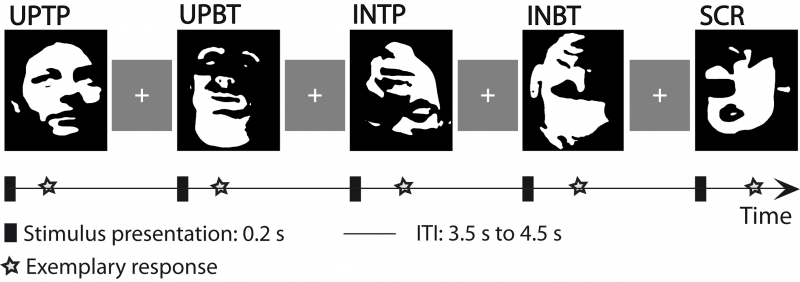How does the brain recognize faces from minimal information?

Our brain recognizes objects within milliseconds, even if it only receives rudimentary visual information. Researchers believe that reliable and fast recognition works because the brain is constantly making predictions about objects in the field of view and is comparing these with incoming information. Only if mismatches occur in this process do higher areas of the brain have to be notified of the error in order to make active corrections to the predictions. Now scientists at the Goethe University have confirmed this hypothesis. As they report in the current edition of the Journal of Neuroscience, those brain waves that are sent to higher brain areas increase their activity when a predictive error occurs. These results also promise a better understanding of schizophrenia and autism spectrum disorders.
In order to induce predictive errors in their subjects, the researchers showed them so-called Mooney faces, named after their inventor Craig Mooney. These are photographs of faces which have been reduced entirely to black and white. We usually recognize these easily. We can even give details about the gender, age and facial expression – despite the fact that only the borders between black and white contain any information about the face. Moreover, even this minimal amount of information is ambiguous, because the boundaries either represent the transition between light and cast shadows or they confine the object itself.
"In our study, we used Mooney faces which intentionally violated two expectations: Firstly, that we always see faces oriented upright, and secondly, that light comes from above. The facial recognition performance became noticably poorer and slower as a result," Prof. Michael Wibral from the Brain Imaging Center at the Goethe University explained.
What happens in the brain in this situation? The current "Predictive Coding" theory suggests that signals only have to be sent to higher brain areas for processing if predictions aren't met. Thus an increase in signal activity towards higher brain areas should occur. However, there are also competing theories which predict the exact opposite.
Testing the theory directly only became possible recently, when Frankfurt scientists at the Strüngmann Institute discovered that brain wave activity at about 90 Hertz increases when signals are sent from lower to higher brain areas. "If a predictive error is induced by generating images which contradict the everyday visual reality learned over the course of a lifetime, then we should see an increase in brain wave activity at 90 Hertz in response to an error. We were able to confirm this experimentally," Wibral explained. "And we were also able to show that the intensity of these 'error brain waves' increases along with the time necessary for recognition. This shows that these brain waves don't just initiate a correction, but also play a causal role in our perception," Wibral continued. The results are important specifically because these brain waves also appear to be significantly impaired in patients with schizophrenia and autism spectrum disorders. This was shown through measurements taken in the laboratory of the Frankfurt Brain Imaging Centre over the past few years. The researchers are now hoping to gain a better understanding of both illnesses and to find ways of helping patients to correct their predictive errors more effectively.
More information: "The Faces of Predictive Coding," Journal of Neuroscience, 17 June 2015. DOI: 10.1523/JNEUROSCI.1529-14.2015















